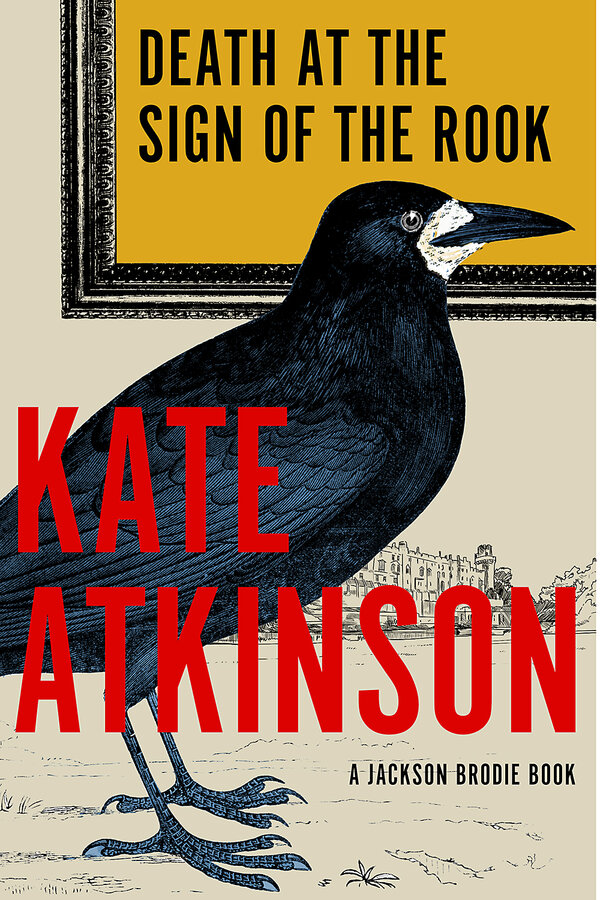Five mysteries to savor, from Kate Atkinson to Richard Osman
Loading...
Lady Justice is supposed to be blind to questions of wealth – but those shiny gold coins sure do seem to affect her scales in a quintet of new mysteries. To say nothing of her hiking up a mountain or through a snowstorm in blindfold, robes, and sandals. Perhaps Justice finds it swifter to travel via private plane?
That may be why private investigator Jackson Brodie has this tendency to try to reassign blame to a guiltier party, in Kate Atkinson’s bestselling series. “He was always making the distinction between justice and the law,” Detective Constable Reggie Chase thinks. “She was always trying not to.”
Atkinson appears to have an absolute hoot playing with Agatha Christie’s tropes in “Death at the Sign of the Rook.” A group of people has come to a moldering country estate for a murder mystery weekend. A touch of “Downton Abbey” has been advertised, but Burton Makepeace is far more “Fawlty Towers.” One of the attendees may have stolen a valuable painting. One might be a killer. Brodie is there to fulfill the role of sleuth – having been tapped to find a stolen painting of questionable provenance whose thief may once have lifted a J.M.W. Turner from the estate.
Why We Wrote This
Sometimes, what you need is a good murder mystery. Our resident mystery fan Yvonne Zipp takes readers on a whirlwind tour of five novels packed with new and returning characters – quirks included.
Atkinson both sends up and deepens stock characters like the vicar, who here has lost his faith; a major who doesn’t feel cut out for civilian life; and the batty lady of the manor, who appears to have arrived via time machine from the Victorian era. The ending may not be completely persuasive, but it’s all in very good fun.
Richard Osman’s new series
I am still recovering from reading Richard Osman’s last “Thursday Murder Club” mystery, so it is entirely plausible that the bestselling writer needed a break from breaking all of our hearts. His new “We Solve Murders” is an altogether lighter affair – an international romp that jets from England to a private island off South Carolina to St. Lucia with stops in Dublin and in Dubai, United Arab Emirates.
Retired police officer turned private investigator Steve Wheeler finds himself drafted by his daughter-in-law, Amy, who provides security for exclusive clientele who have perhaps annoyed a member of the Russian mafia. Someone is killing Amy’s clients, and appears to want to a) kill her and b) frame her for the murders.
Steve unwillingly finds himself packing up his vintage heavy metal T-shirts and flying to the rescue. Along for the ride – and providing the private plane – is the “second-bestselling crime novelist in the world” after Lee Child. Rosie D’Antonio is a delightful septuagenarian who sees all the mayhem as a way to stave off boredom before afternoon cocktails. “We Solve Murders” is a charming palate cleanser, but the book largely serves as a get-to-know-you for Osman’s new series.
A disappearance at summer camp
The Adirondacks have been the site of both great wealth and great poverty since the robber barons of the first Gilded Age thought to rusticate in the mountains. Here, Camp Emerson sits awkwardly next to a massive estate – both named for Ralph Waldo Emerson. Neither the estate’s mansion (christened Self-Reliance with breathtaking hubris) nor the banking tycoon who founded it would have impressed the New England philosopher.
As “The God of the Woods” opens, eight girls wake up in a cabin where nine had gone to bed the night before. Barbara, the missing girl, is a scion of the big house. And she’s not the first child of that family to have disappeared.
Liz Moore’s excellent interrogation of class and generational injustice hopscotches among the 1950s, 1961, and the summer of 1975. While those woods are perilously easy to lose one’s way in, Moore’s moral compass never veers off true north.
Murder in an Italian village
For understanding the menace that lurks in a small village, Juliet Grames has penned a tale that would have Miss Marple bowing her head in mournful silence. “The Lost Boy of Santa Chionia” is set in the mountainous region of Calabria, Italy, in 1960. There are many goatherds, but this isn’t “Heidi.” Everyone tells the new nursery school teacher, American Francesca Loftfield, how safe the village is. You know, except for the mob justice meted out on corrupt priests. Oh, and there’s the occasional young man who “emigrated to America” and never, ever wrote home again. And the skeleton that just slid out from the post office’s foundation during a flood, and that no one seems terribly interested in identifying besides Francesca. “My training had prepared me to weather many forms of calamity, but not, it turned out, evidence of cold-blooded murder.”
The region is so poor and so remote that Francesca’s landlady was 30 years old before she first saw money. But even without cash, Santa Chionia’s way of life extracts harsh payment for deviation from what the village understands is necessary to keep that way of life unchanged. “My father used to tell me that growing up meant understanding who was at fault wasn’t what mattered; what mattered was who had to pay the consequences,” Francesca writes.
Secrets and lies in the Himalayas
Consequences loom large in “Death in the Air,” our final mystery taking place at high altitudes. Attorney Ro Krishna, flush from a legal settlement that came after a racist boss deprived him of his work, has decided to spend Christmas in the Himalayas at a luxury yoga retreat. Then a fellow guest is found murdered, and the owner asks the lawyer to step in and act as in-house counsel. Also staying at the retreat are a Hollywood star, a sort-of-former CIA agent, and the Visiting Blight, er, Light, a white yogi brought in “to teach yoga to Indian people.” This is the type of slow-burn story in which glamorous people conceal secrets behind smiles, while assuring one another that they are totally incapable of lying.
“I don’t know why, but I have a feeling I can trust you. Can I?” a character asks Ro. “For future reference, never ask anybody that again,” he responds.
In “Death in the Air,” explorations of inequality have more to do with questions of immigration, identity, race, and generational wrongs than of money. Most of the dramatis personae are so loaded that they regard Panthère de Cartier watches as sentimental trinkets.
Ro himself is an utter charmer who carries the novel past its stutter-start opening, which takes us to Bermuda and London before landing where the action is. There is one subplot that had me gritting my teeth – deus ex pendulum is not a plot device that will work for every reader – and author Ram Murali doesn’t quite stick the landing. But I would happily sign on for another trip with Ro, even to a low-budget motel with a Cracker Barrel outside.













